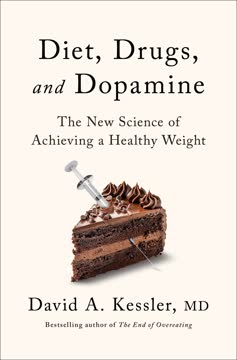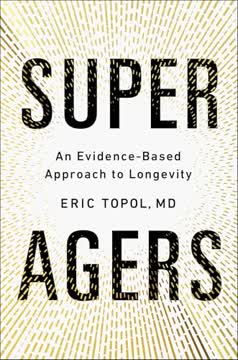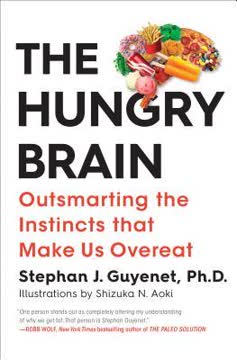Key Takeaways
1. Obesity is a Brain-Based Addiction, Not a Willpower Failure.
The fact that the new anti-obesity drugs are highly effective underscores the fact that being overweight or obese is not a product of lack of discipline or willpower—a bias that has long prevailed, even within the medical profession.
A biological battle. For too long, society and even the medical community have blamed individuals for their weight struggles, attributing obesity to a lack of discipline. However, new evidence, particularly the efficacy of anti-obesity medications, reveals that obesity is fundamentally a biological phenomenon, deeply rooted in brain chemistry and physiological processes. It's a battle against our own biology, not a moral failing.
Food noise and cravings. The core of this biological struggle is "food noise"—a constant, clamorous chorus of food-focused thoughts and cravings that plays on repeat in our heads. This preoccupation with food is a hallmark of addiction, triggered by the ultraformulated foods that have commandeered our brain's reward centers. These foods alter neurohormones that control weight, increasing our average weight settling point.
Addiction's opponent process. The addictive nature of food manifests as an "opponent process" in the brain. The initial pleasure from eating ultraformulated foods (the "a" process) is inevitably followed by a negative emotional state or withdrawal (the "b" process), which the author calls "hyperkatifeia." This discomfort drives compulsive eating, creating a cycle of despair and temporary relief that reinforces the addiction.
2. Ultraformulated Foods Are the "New Cigarette," Engineered for Overconsumption.
In many ways, ultraformulated foods have become the new cigarette.
Engineered for addiction. Just as the tobacco industry manipulated nicotine levels and used aggressive marketing to addict millions, the food industry has engineered "ultraformulated" foods to be irresistible. These products deliver precise combinations of fat, sugar, and salt—often called "the three points of the compass"—that powerfully trigger the brain's reward centers, leading to compulsive cravings and overeating.
Environmental commandeering. The widespread availability and constant marketing of these energy-dense, high-glycemic foods have created an "obesogenic environment." This environment constantly bombards our brains with cues—sights, smells, locations—that stimulate arousal and incite cravings, often outside our conscious awareness. This environmental shift has fundamentally altered our bodies' natural weight range, making obesity our default setting.
Beyond convenience. While some argue ultraformulated foods were created for modern convenience, the industry has continuously upped the ante, prioritizing hedonic aspects that drive us to eat more, faster, and more often. This ongoing "insult to our brains" triggers addictive circuits, changing our physiology. The parallel to the tobacco industry's tactics, which took a century to expose, is stark and concerning.
3. Our Biology Is Betrayed: Evolved for Scarcity, Trapped by Abundance.
The human brain evolved to deal with scarcity, not abundance.
A mismatch of design. Our biological systems are fundamentally designed for survival in an environment of scarcity, programmed to seek out the sweetest and most energy-dense foods and to hold onto body fat. This ancient wiring is now tragically mismatched with our modern world of food abundance, explaining the skyrocketing obesity rates over the last fifty years. Our bodies are designed to fight against weight loss.
Homeostatic vs. hedonic systems. The body's homeostatic system aims to maintain energy balance, but the hedonic (reward) system, driven by pleasure, can override it. The hedonic system doesn't care about energy balance; it cares about reward. This creates a conflict where the brain defends its highest fat mass, making weight loss incredibly difficult.
The "wanting" molecule. Dopamine, the "wanting" molecule, plays a critical role in the hedonic system, strengthening neurocircuits that pursue salient stimuli like high-fat, high-sugar foods. These dopamine spikes, followed by drops, create dysphoria, driving us to use food as a coping mechanism. This addiction cycle, combined with metabolic adaptation (slowed metabolism, increased appetite after weight loss), creates a "perfect storm for weight regain."
4. GLP-1 Drugs Offer a Powerful Reset by Taming Appetite and Cravings.
With the help of GLP-1s, I reached a BMI I never thought I would achieve.
A new era of treatment. GLP-1 (glucagon-like peptide-1) drugs represent a revolutionary breakthrough in obesity treatment, offering a powerful tool to reset the body's weight. These weekly injectable medications, like semaglutide and tirzepatide, work by influencing gastrointestinal hormones, profoundly changing how people respond to food.
Mechanism of action. GLP-1s primarily work by:
- Delayed gastric emptying: Food stays in the stomach longer, intensifying satiety signals.
- Dampened reward response: They reduce the brain's hedonic response to food, quieting "food noise."
- Aversive system activation: They stimulate toxin-detecting receptors, making excessive eating feel unpleasant or nauseating.
This combination allows users to drastically reduce caloric intake without the usual feelings of deprivation.
Beyond weight loss. The benefits extend beyond weight reduction, including:
- Reduced risk of heart disease, kidney disease, and fatty liver disease.
- Lower blood pressure and improved lipid profiles.
- Potential to reduce alcohol and opioid cravings, suggesting a broader impact on addictive behaviors.
However, these drugs are not without risks, including gastrointestinal side effects, potential malnutrition, and the need for long-term use.
5. Sustainable Weight Loss Demands a Multi-Faceted, Personalized Approach.
Realistically, then, the journey requires choosing what is best for you among these choices—drugs, nutrition, physical activity, and behavioral therapy—and understanding how to combine them or switch emphasis if one approach begins to wane in its effectiveness.
No magic bullet. While GLP-1 drugs are powerful, they are not a standalone solution or a "magic pill." Obesity is a chronic, relapsing disease influenced by biological, psychological, and social factors. Therefore, effective, sustainable weight management requires a comprehensive, individualized strategy that integrates multiple tools.
The collaborative system. The ideal approach combines:
- Anti-obesity medications: To reset appetite and reduce cravings.
- Nutrition therapy: To ensure adequate nutrient intake and healthy food choices.
- Physical activity: Especially resistance training, to preserve muscle mass and boost metabolism.
- Behavioral therapies: To address emotional eating, stress, and environmental cues.
These elements work synergistically, with medications making lifestyle changes more achievable by reducing the physiological drive to overeat.
Lifelong commitment. Weight loss is a winding, unpredictable journey, not a destination. Patients must be prepared for a lifelong commitment to managing their health, adapting their strategies as their needs and circumstances change. This includes understanding that discontinuing GLP-1s often leads to weight regain, necessitating a sustainable plan for post-medication maintenance.
6. Nutrition Therapy: Prioritize Whole, Unprocessed Foods to Counter Metabolic Chaos.
Eating whole foods, and avoiding highly processed foods, must be a central tenet of any health-promoting nutritional therapy plan.
Food is not the enemy. The problem isn't food itself, but "ultraformulated food," which acts like a complex drug. Its altered microstructure and added ingredients (sugar, fat, salt) bypass natural satiety signals, leading to overconsumption and metabolic chaos. Nutrition therapy must focus on reversing this by prioritizing whole, minimally processed foods.
Key dietary principles: An effective nutrition plan, whether with or without GLP-1s, should:
- Moderate lean protein intake: Essential for muscle synthesis, satiety, and metabolism (25-40% of daily calories).
- Plant-predominant eating: Rich in fiber, vitamins, minerals, and antioxidants, reducing inflammation and supporting gut health.
- Healthy fats: Emphasize unsaturated fats like omega-3s (olive oil, fish, nuts) while reducing proinflammatory omega-6s from seed oils.
- High-fiber, low-glycemic carbohydrates: Minimize rapidly digestible carbs (sugars, refined starches) that cause blood sugar spikes and insulin resistance.
Beyond calories. While a caloric deficit is crucial for weight loss, nutrition therapy goes deeper. It aims to reduce reward responsiveness, increase satiety, and stabilize blood glucose and insulin levels. This shift in food preferences, facilitated by GLP-1s, makes it easier to choose nutrient-dense foods and maintain a healthy eating pattern long-term.
7. Behavioral Change Must Address Neurobiology, Not Just Conscious Effort.
What’s needed are behavioral therapies, according to Dr. Brewer, “that influence addictive behaviors by altering the lower-level reinforcement learning mechanisms responsible for instilling these behaviors in the first place.”
Beyond willpower. Traditional cognitive behavioral therapy often falls short in treating food addiction because it attempts "top-down regulation" over behaviors rooted in "lower-level reward-based systems." Effective behavioral therapy must instead address the neurobiology of addiction, shifting our perception of food as a reward and altering the underlying reinforcement mechanisms.
Emotional drivers. Addictive eating is driven by how we feel, not just what we think. Internal (hunger, stress, boredom) and external (food cues) stimuli trigger emotional responses that lead to automatic eating behaviors. Stress, in particular, sustains food addiction by favoring the brain's salience network over executive control, leading to "stress eating."
Strategies for neurobiological change:
- Motivation: Substitute ultraformulated food rewards with new, positive behaviors.
- Avoidance: Reframe addictive foods as negatively associated (like cigarettes), reducing their allure.
- Assertion (Homeostasis): Achieve a state of inner calm and balance, making this peace more rewarding than compulsive eating.
- Environmental manipulation: Make cravings harder to fulfill by altering immediate surroundings.
- Sleep optimization: Improve sleep quality to enhance executive control and reduce hedonic responses to food.
These approaches aim to change the "salience" of food, making healthy choices feel more intrinsically rewarding.
8. The Food Industry's Deception Requires Radical Transparency and Regulation.
You could not have designed a better weapon to blow up the human body.
A weaponized food supply. The modern food industry has weaponized food, transforming natural ingredients into "ultraformulated" products that are hyperpalatable, energy-dense, and designed for rapid consumption. This processing strips foods of their natural microstructure, adds addictive combinations of fat, sugar, and salt, and contributes directly to obesity, diabetes, and cardiovascular disease.
Deceptive marketing. The industry spends billions on marketing campaigns that de-stigmatize unhealthy products and imply healthfulness, often through misleading labels like "fat-free" or "all-natural." This "virtue signaling" distracts consumers from the true composition and health impacts of their products, mirroring tactics once used by the tobacco industry.
Food Label 2.0. To combat this, radical transparency is needed. The author proposes a "Food Label 2.0" that goes beyond current nutrition facts:
- Front-of-package warning labels for harmful foods.
- Listing the top three ingredients clearly.
- A full product dossier accessible via smartphone, detailing ingredients, function, processing steps, and impact on insulin/blood glucose.
- Quantitative ingredient declarations and graphic readability standards.
This system would empower consumers and incentivize companies to prioritize public health.
9. The GLP-1 Gold Rush: Benefits Come with Significant Risks and Equity Challenges.
I want to hold the food industry responsible for its actions, but I want to hold the medical and pharmaceutical industries to a higher standard as well.
Unprecedented financial windfall. The GLP-1 market is experiencing a "Gold Rush," with projected annual revenues soaring into the tens of billions. This financial incentive drives intense marketing, celebrity endorsements, and media hype, creating a frenzied demand for these drugs.
Chaos and risks. This rapid expansion, however, is marked by chaos and significant risks:
- Misuse: Drugs are prescribed for aesthetic reasons or without proper medical oversight.
- Copycat versions: Compounding pharmacies fill shortages with unregulated, potentially unsafe versions, often at lower costs.
- Lack of data: Insufficient long-term studies on safety, efficacy, and intermittent use.
- Adverse events: Gastroparesis, malnutrition, and other serious side effects are underreported or not fully understood.
The FDA and medical community are struggling to provide adequate oversight, leaving patients vulnerable.
Equity and access. The high cost of GLP-1s (over $1,000/month) creates significant equity challenges. Many insurance companies deny coverage, forcing patients to choose between questionable alternatives or foregoing treatment. This discrimination against obesity as a disease, despite its profound health impacts, highlights a systemic failure to provide essential medical care.
10. A Societal Food Revolution is Essential for Long-Term Health and Freedom.
If we truly want to make America healthy, we are going to have to take on ultraformulated foods.
Beyond individual solutions. While GLP-1 drugs offer a powerful personal tool, they only mask the root cause of the obesity epidemic. The ultimate solution requires a societal shift—a "food revolution"—to dismantle the system that promotes addictive, ultraformulated foods and restore public health.
A call to action. This revolution demands:
- Accountability: Holding food manufacturers responsible for the health damage caused by their products.
- Improved diet quality: Making whole, unprocessed foods the default, not the exception.
- Education: Starting in childhood, teaching about healthy eating, active lifestyles, and emotional regulation.
- Investment in nutrition research: Establishing a national institute of nutrition to understand the fundamental links between diet and health.
- Regulatory reform: Empowering the FDA to implement transparent labeling and regulate hyperpalatable foods.
Reclaiming health and autonomy. The current health crisis, marked by rising obesity, diabetes, and chronic diseases, is an urgent alarm. By confronting the food industry's manipulation and collectively committing to systemic change, we can reclaim our health, autonomy, and ensure a healthier future for generations to come, free from the grip of food addiction.
Last updated:
Review Summary
Diet, Drugs, and Dopamine explores the science of weight loss, focusing on GLP-1 drugs and their potential benefits and risks. Kessler examines food addiction, ultra-processed foods, and the challenges of maintaining weight loss. Reviewers appreciate the book's comprehensive approach, scientific depth, and personal anecdotes. While some find it informative and eye-opening, others criticize its repetitiveness and pro-GLP-1 stance. The book is praised for its accessible explanations of complex topics and its critique of the food and pharmaceutical industries.
Similar Books
Download PDF
Download EPUB
.epub digital book format is ideal for reading ebooks on phones, tablets, and e-readers.











